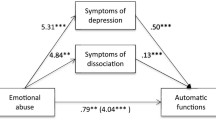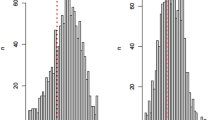Abstract
Acute reactions to trauma are examined in 267 individuals severely injured via community violence. Respondents were interviewed about pretrauma, peritraumatic, and acute posttraumatic factors. A series of bivariate and multivariate analyses were conducted. We found few factors related to peritraumatic dissociation (PD): only injury severity and neuroticism emerged as multivariate predictors and the effects were small. PD was strongly related to acute PTSD symptoms, and partially mediated the relationship between other factors and acute PTSD and general distress symptoms. Different patterns of predictors emerged for acute PTSD symptoms vis-à-vis general distress symptoms. Future research on predictors of PD is indicated to develop prevention and early intervention programs.
Similar content being viewed by others
References
Allen, J. G., Coyne, L., Huntoon, J. (1998). Trauma pervasively elevates Brief Symptom Inventory profiles in inpatient women. Psychological Reports, 83, 499-513.
American Psychiatric Association. (1994). Diagnostic and statistical manual of mental disorders (4 ed.). Washington, DC: Author.
Andrynowski, M. A., Cordova, M. J., Studts, J. L., Miller, T. W. (1998). Post-traumatic stress disorder after treatment for breast cancer: Prevalence of diagnosis and use of the PTSD Checklist-Civilian Version (PCL-C) as a screening instrument. Journal of Consulting and Clinical Psychology, 66, 586-590.
Association for the Advancement of Automotive Medicine. (1990). The Abbreviated Injury Scale (revision). Des Plaines, IL: Author.
Babor, T. F., de la Fuente, J. R., Saunders, J., Grant, M. (1989). The Alcohol Use Disorders Identification Test: Guidelines for use in primary health care. Geneva, Switzerland: World Health Organization.
Birmes, P., Carreras, D., Charlet, J. P., Warner, B. A., Lauque, D., Schmitt, L. (2001). Peritraumatic dissociation and posttraumatic stress disorder in victims of violent assault. Journal of Nervous and Mental Disease, 189, 796-798.
Blanchard, E. B., Hickling, E. J., Barton, K. A., Taylor, A. E., Loos, W. R., Jones-Alexander, J. (1996). One-year prospective follow-up of motor vehicle accident victims. Behaviour Research and Therapy, 34, 775-786.
Blanchard, E. B., Jones-Alexander, J., Buckley, T., Forneris, C. A. (1996). Psychometric properties of the PTSD Checklist (PCL). Behaviour Research and Therapy, 34, 669-673.
Bramsen, I., Dirkzwager, A. J., van der Ploeg, H. M., (2000). Predeployment personality traits and exposure to trauma as predictors of posttraumatic stress symptoms: A prospective study of former peacekeepers. American Journal of Psychiatry, 157, 1115-1119.
Bremner, J. D., Southwick, S., Brett, E., Fontana, A., Rosenheck, R., Charney, D. S. (1992). Dissociation and posttraumatic stress disorder in Vietnam combat veterans. American Journal of Psychiatry, 149, 328-332.
Breslau, N., Davis, G. C., Andreski, P., Peterson, E. (1991). Traumatic events and posttraumatic stress disorder in an urban population of young adults. Archives of General Psychiatry, 48, 216-222.
Brewin, C. R., Andrews, B., Rose, S., Kirk, M. (1999). Acute stress disorder and posttraumatic stress disorder in victims of violent crime. American Journal of Psychiatry, 156, 360-366.
Bryant, R. A., Harvey, A. G. (1996). Initial posttraumatic stress responses following motor vehicle accidents. Journal of Traumatic Stress, 9, 223-234.
Bryant, R. A., Moulds, M. L., Guthrie, R. M., (2000). Acute Stress Disorder Scale: A self-report measure of acute stress disorder. Psychological Assessment, 12, 61-68.
Cardena, E., Koopman, C., Classen, C., Waelde, L., Spiegel, D. (2000). Psychometric properties of the Stanford Acute Stress Reaction Questionnaire (SASRQ): A valid and reliable measure of acute stress. Journal of Traumatic Stress, 13, 719-734.
Costa, P. T., McCrae, R. R., (1989). NEO Five-Factor Inventory: Form S. Odessa, FL: Psychological Assessment Resources.
Derogatis, L. R., Melisaratos, N. (1983). The Brief Symptom Inventory: An introductory report. Psychological Medicine, 13, 595-605.
Freedman, S. A., Brandes, D., Peri, T., Shalev, A. (1999). Predictors of chronic post-traumatic stress disorder. A prospective study. British Journal of Psychiatry, 174, 353-359.
Fullerton, C. S., Ursano, R. J., Epstein, R. S., Crowley, B., Vance, K. L., Kao, T. C., et al. (2000). Peritraumatic dissociation following motor vehicle accidents: Relationship to prior trauma and prior major depression. Journal of Nervous and Mental Disease, 188, 267-272.
Gallagher, J. G., Riggs, D. S., Byrne, C. A., Weathers, F. W. (1998). Female partners' estimations of male veterans' combat-related PTSD severity. Journal of Traumatic Stress, 11, 367-374.
Gottfredson, M. R. (1984). Victims of crime: The dimensions of risk. London: Home Office.
Griffin, M. G., Resick, P. A., Mechanic, M. B., (1997). Objective assessment of peritraumatic dissociation: Psychophysiological indicators. American Journal of Psychiatry, 154, 1081-1088.
Hindelang, M., Gottfredson, M. R., Garofalo, J. (1978). Victims of personal crime: An empirical foundation for a theory of personal victimization. International Journal of the Addictions, 25, 1065-1081.
Holeva, V., Tarrier, N. (2001). Personality and peritraumatic dissociation in the prediction of PTSD in victims of road traffic accidents. Journal of Psychosomatic Research, 51, 687-692.
Koopman, C., Classen, C., Spiegel, D. (1994). Predictors of posttraumatic stress symptoms among survivors of the Oakland/Berkeley, Calif., firestorm. American Journal of Psychiatry, 151, 888-894.
Koopman, C., Classen, C., Spiegel, D. (1996). Dissociative responses in the immediate aftermath of the Oakland/Berkeley firestorm. Journal of Traumatic Stress, 9, 521-540.
Maisto, S. A., Conigliaro, J., McNeil, M., Kraemer, K., Kelley, M. E., (2000). An empirical investigation of the factor structure of the AUDIT. Psychological Assessment, 12, 346-353.
Marmar, C. R., Weiss, D. S., Metzler, T. J., (1997). The Peritraumatic Dissociative Experiences Questionnaire. In J. P. Wilson T. M. Keane (Eds.), Assessing psychological trauma and PTSD (pp. 412-428). New York: Guilford Press.
Marmar, C. R., Weiss, D. S., Metzler, T. J., Delucchi, K. (1996). Characteristics of emergency services personnel related to peritraumatic dissociation during critical incident exposure. American Journal of Psychiatry, 153(Suppl.), 94-102.
Marmar, C. R., Weiss, D. S., Schlenger, W. E., Fairbank, J. A., Jordan, B. K., Kulka, R. A., et al. (1994). Peritraumatic dissociation and posttraumatic stress in male Vietnam theater veterans. American Journal of Psychiatry, 151, 902-907.
Marshall, G. N., Orlando, M. (2002). Acculturation and peritraumatic dissociation in young adult Latino survivors of community violence. Journal of Abnormal Psychology, 111, 166-174.
Marshall, G. M., Orlando, M., Jaycox, L., Foy, D., Belzberg, H. (2002). Development and validation of a modified version of the Peritraumatic Dissociative Experiences Questionnaire. Psychological Assessment, 4, 123-134.
Mayou, R. A., Ehlers, A., Hobbs, M. (2000). Psychological debriefing for road traffic accident victims. Three-year follow-up of a randomised controlled trial. British Journal of Psychiatry, 176, 589-593.
McFarlane, A. C. (1988). The aetiology of post-traumatic stress disorders following a natural disaster. British Journal of Psychiatry, 152, 116-121.
McFarlane, A. C. (2000). Posttraumatic stress disorder: A model of the longitudinal course and the role of risk factors. Journal of Clinical Psychiatry, 61(Suppl. 5), 15-20.
Michaels, A. J., Michaels, C. E., Moon, C. H., Zimmerman, M. A., Peterson, C., Rodriguez, J. L. (1998). Psychosocial factors limit outcomes after trauma. Journal of Trauma, 44, 644-648.
Michaels, A. J., Michaels, C. E., Smith, J. S., Moon, C. H., Peterson, C., Long, W. B. (2000). Outcome from injury: General health, work status, and satisfaction 12 months after trauma. Journal of Trauma, 48, 841-848; discussion 848-850.
Norris, F. H., Kaniasty, K. (1994). Psychological distress following criminal victimization in the general population: Cross-sectional, longitudinal, and prospective analyses. Journal of Consulting and Clinical Psychology, 62, 111-123.
Reiss, A. J., Roth, J. A. (1993). Understanding and preventing violence. Washington, DC: National Academy Press.
Rennison, C. M. (2000). Criminal victimization 1999: Changes 1998-99 with trends 1993-99. Research in Marketing, 1, 91-112.
Resnick, H. S., Kilpatrick, D. G., Dansky, B. S., Saunders, B. E., Best, C. L., (1993). Prevalence of civilian trauma and posttraumatic stress disorder in a representative national sample of women. Journal of Consulting and Clinical Psychology, 61, 984-991.
Richters, J. E., Saltzman, W. (1990). Survey of children's exposure to community violence. Bethesda, MD: National Institute of Mental Health.
Rost, K., Burnam, M. A., Smith, G. R., (1993). Development of screeners for depressive disorders and substance disorder history. Medical Care, 31, 189-200.
Sarason, I. G., Johnson, J. H., Siegel, J. M., (1978). Assessing the impact of life changes: Development of the Life Experiences Survey. Journal of Consulting and Clinical Psychology, 46, 932-946.
Shalev, A. Y. (2001). What is posttraumatic stress disorder? Journal of Clinical Psychiatry, 62(Suppl. 17), 4-10.
Shalev, A. Y., Freedman, S., Peri, T., Brandes, D., Sahar, T., Orr, S. P., et al. (1998). Prospective study of posttraumatic stress disorder and depression following trauma. American Journal of Psychiatry, 155, 630-637.
Shalev, A. Y., Peri, T., Canetti, L., Schreiber, S. (1996). Predictors of PTSD in injured trauma survivors: A prospective study. American Journal of Psychiatry, 153, 219-225.
Sherbourne, C. D., Stewart, A. L. (1991). The MOS Social Support Survey. Social Science and Medicine, 32, 705-714.
Southwick, S. M., Morgan, C. A., Nicolaou, A. L., Charney, D. S. (1997). Consistency of memory for combated-related traumatic events in veterans of Operation Desert Storm. American Journal of Psychiatry, 154, 173-177.
Teasdale, G., Jennet, B. (1974). Assessment of coma and impaired consciousness: A practical scale. Lancet, 2, 81-84.
Tichenor, V., Marmar, C. R., Weiss, D. S., Metzler, T. J., Ronfeldt, H. M., (1996). The relationship of peritraumatic dissociation and posttraumatic stress: Findings in female Vietnam theater veterans. Journal of Consulting and Clinical Psychology, 64, 1054-1059.
Ursano, R. J., Fullerton, C. S., Epstein, R. S., Crowley, B., Kao, T. C., Vance, K., et al. (1999). Acute and chronic posttraumatic stress disorder in motor vehicle accident victims. American Journal of Psychiatry, 156, 589-595.
van der Kolk, B. A., Fisler, R. (1995). Dissociation and the fragmentary nature of traumatic memories: Overview and exploratory study. Journal of Traumatic Stress, 8, 505-525.
van der Kolk, B. A., van der Hart, O. (1989). Pierre Janet and the breakdown of adaptation in psychological trauma. American Journal of Psychiatry, 146, 1530-1540.
Weathers, F. W., Litz, B. T., Herman, D. S., Huska, J. A., Keane, T. M. (1993, October). The PTSD Checklist (PCL): Reliability, validity, and diagnostic validity. Paper presented at the annual meeting of the International Society for Traumatic Stress Studies, San Antonio, TX.
Wirtz, P. W., & Harrell, A. V., (1987). Victim and crime characteristics, coping responses, and short-and long-term recovery from victimization. Journal of Consulting & Clinical Psychology, 55(6), 866-871.
Author information
Authors and Affiliations
Corresponding author
About this article
Cite this article
Jaycox, L.H., Marshall, G.N. & Orlando, M. Predictors of Acute Distress Among Young Adults Injured by Community Violence. J Trauma Stress 16, 237–245 (2003). https://doi.org/10.1023/A:1023739922809
Issue Date:
DOI: https://doi.org/10.1023/A:1023739922809




